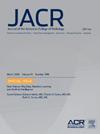多种镜头乳腺成像在不同的设置:对实践,政策和研究的影响。
IF 5.1
3区 医学
Q1 RADIOLOGY, NUCLEAR MEDICINE & MEDICAL IMAGING
引用次数: 0
摘要
乳腺癌是全世界癌症死亡的主要原因,也是最常见的癌症。根据世界卫生组织的定义,“健康公平被定义为在社会、经济、人口或地理上定义的人口群体之间不存在不公平的、可避免的或可补救的健康差异。”实现卫生公平可以解决所有医学领域的差距,包括获得乳房成像和改善乳腺癌结局。因此,重要的是要认识到各种实践类型的独特挑战,包括在安全网、社区和全球环境中,当涉及到乳房健康和成像不公平时,并从实践、政策和研究的角度制定缩小差距的战略。本文章由计算机程序翻译,如有差异,请以英文原文为准。
Multiple Lenses on Breast Imaging in Diverse Settings: Implications for Practice, Policy, and Research
Breast cancer is the leading cause of death from cancer worldwide and is the most common cancer. According to the World Health Organization, “health equity is defined as the absence of unfair and avoidable or remediable differences in health among population groups defined socially, economically, demographically, or geographically.” Achieving health equity can address disparities in all arenas of medicine, including access to breast imaging and improving breast cancer outcomes. Thus, it is important to recognize the unique challenges of diverse practice types, including in the safety-net, community, and global setting when it comes to breast health and imaging inequities, as well as to formulate strategies to bridge the gap, from a practice, policy, and research perspective.
求助全文
通过发布文献求助,成功后即可免费获取论文全文。
去求助
来源期刊

Journal of the American College of Radiology
RADIOLOGY, NUCLEAR MEDICINE & MEDICAL IMAGING-
CiteScore
6.30
自引率
8.90%
发文量
312
审稿时长
34 days
期刊介绍:
The official journal of the American College of Radiology, JACR informs its readers of timely, pertinent, and important topics affecting the practice of diagnostic radiologists, interventional radiologists, medical physicists, and radiation oncologists. In so doing, JACR improves their practices and helps optimize their role in the health care system. By providing a forum for informative, well-written articles on health policy, clinical practice, practice management, data science, and education, JACR engages readers in a dialogue that ultimately benefits patient care.
 求助内容:
求助内容: 应助结果提醒方式:
应助结果提醒方式:


